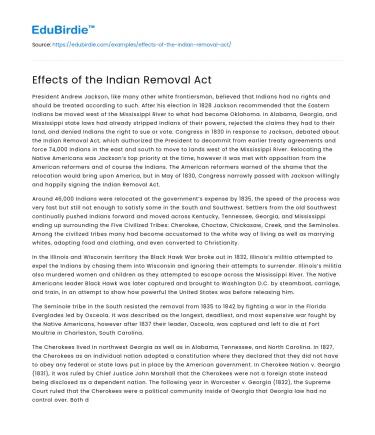President Andrew Jackson, like many other white frontiersman, believed that Indians had no rights and should be treated according to such. After his election in 1828 Jackson recommended that the Eastern Indians be moved west of the Mississippi River to what had become Oklahoma. In Alabama, Georgia, and Mississippi state laws had already stripped Indians of their powers, rejected the claims they had to their land, and denied Indians the right to sue or vote. Congress in 1830 in response to Jackson, debated about the Indian Removal Act, which authorized the President to decommit from earlier treaty agreements and force 74,000 Indians in the east and south to move to lands west of the Mississippi River. Relocating the Native Americans was Jackson’s top priority at the time, however it was met with opposition from the American reformers and of course the Indians. The American reformers warned of the shame that the relocation would bring upon America, but in May of 1830, Congress narrowly passed with Jackson willingly and happily signing the Indian Removal Act.
Around 46,000 Indians were relocated at the government’s expense by 1835, the speed of the process was very fast but still not enough to satisfy some in the South and Southwest. Settlers from the old Southwest continually pushed Indians forward and moved across Kentucky, Tennessee, Georgia, and Mississippi ending up surrounding the Five Civilized Tribes: Cherokee, Choctaw, Chickasaw, Creek, and the Seminoles. Among the civilized tribes many had become accustomed to the white way of living as well as marrying whites, adopting food and clothing, and even converted to Christianity.
Save your time!
We can take care of your essay
- Proper editing and formatting
- Free revision, title page, and bibliography
- Flexible prices and money-back guarantee
In the Illinois and Wisconsin territory the Black Hawk War broke out in 1832, Illinois’s militia attempted to expel the Indians by chasing them into Wisconsin and ignoring their attempts to surrender. Illinois’s militia also murdered women and children as they attempted to escape across the Mississippi River. The Native Americans leader Black Hawk was later captured and brought to Washington D.C. by steamboat, carriage, and train, in an attempt to show how powerful the United States was before releasing him.
The Seminole tribe in the South resisted the removal from 1835 to 1842 by fighting a war in the Florida Everglades led by Osceola. It was described as the longest, deadliest, and most expensive war fought by the Native Americans, however after 1837 their leader, Osceola, was captured and left to die at Fort Moultrie in Charleston, South Carolina.
The Cherokees lived in northwest Georgia as well as in Alabama, Tennessee, and North Carolina. In 1827, the Cherokees as an individual nation adopted a constitution where they declared that they did not have to obey any federal or state laws put in place by the American government. In Cherokee Nation v. Georgia (1831), it was ruled by Chief Justice John Marshall that the Cherokees were not a foreign state instead being disclosed as a dependent nation. The following year in Worcester v. Georgia (1832), the Supreme Court ruled that the Cherokees were a political community inside of Georgia that Georgia law had no control over. Both decisions were on the Cherokee’s side that their ancestral lands could not be taken from them, President Jackson although refused to enforce the Court’s decisions. While the Indians were being forced out, there were no other options except to sign a treaty, which is what the Cherokees did in 1835. They gave up around 100 million acres of their land in exchange for ‘Indian Territory’ in present-day Oklahoma (around 32 million acres). By 1838, around 17,000 Cherokees had been forced out of their homes and moved west in the ‘Trail of Tears’, a forced 800 mile journey made mostly on foot. A select few Indians held out and acquired title to land in North Carolina, later on becoming known as the Eastern Band of Cherokees.






 Stuck on your essay?
Stuck on your essay?

